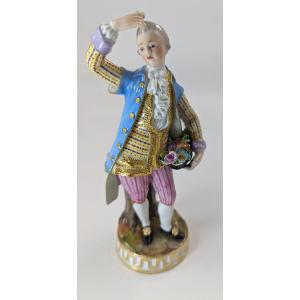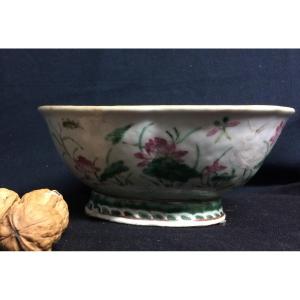"Antique Vase By Hotoda, Satsuma, Meiji Period (1868-1912)"
This antique hand-painted earthenware vase, created by Takichi Hotoda in the late 19th century. Experts believes that he was one of the last great masters of Satsuma during the Meiji period. Hotoda ranks among the late Meiji masters of Satsuma decoration, especially when it comes to motifs of religious figures. He also dealt with the marketing of his products. The piece is a remarkable example of the baluster-shaped vessels characteristic of this period. It features figural and blossom decorations, with panels depicting a Japanese family in an outdoor setting. The scene includes traditional houses, mountains, and an iconic element of Japanese culture-cherry blossoms. The remaining surface of the vase is embellished with intricate floral patterns, and the neck bears the Shimazu crest, a stylized cross, indicating its origin from the Satsuma region. This Shimazu Mon, often placed on the underside of Satsuma pieces or incorporated into the design, signifies the patronage of the powerful Shimazu family, who historically ruled the area. The vase is further distinguished by its relief decoration, where raised elements, such as enamel dots, give a textured, three-dimensional effect. This technique adds depth and complexity to the imagery. The vase is signed on the bottom - made by Hotoda, Yokohama export, Satsuma; this further enhancing its collectible value. Practically speaking Hotoda mark usually is associated with some of the best quality wares to bear a Satsuma mark during the Meiji period.
Satsuma ware has a long history, dating back to the late 16th century when the first kilns were established in the region. Initially, the pottery was simple and utilitarian, but under the guidance of the Shimazu family, it evolved into a refined art form in the late 17th century. The family encouraged the production of high-quality ceramics as a means of bolstering the local economy. Satsuma potters began experimenting with new designs and techniques, leading to the creation of a wide range of ceramics, from tea bowls and sake cups to more elaborate vases and figurines. During the Meiji period (1868-1912), Satsuma ware gained widespread popularity both in Japan and internationally, thanks to government efforts to promote Japanese goods abroad. The pieces exported during this time were often decorated with lavish gold and silver and featured traditional Japanese motifs, such as cherry blossoms and chrysanthemums. Today, Satsuma ware is still produced in Kagoshima prefecture and other parts of Japan, and it remains highly prized for its intricate designs and rich history, with modern interpretations continuing to incorporate both traditional and contemporary themes.
Dimensions: height 25 cm, diameter at the widest part 13 cm, weight 1486 grams,
Condition: network on the enamel from age, but it is noticeable only if to look very close, there are scuffs gilding, small crack from firing on the bottom,but in general excellent antique condition.
Please, study the accompanying photographs carefully as they form an integral part of this description. The item will be shipped with full tracking and insurance. It is important to note that shipping costs include labour, packaging and postage.


















































 Le Magazine de PROANTIC
Le Magazine de PROANTIC TRÉSORS Magazine
TRÉSORS Magazine Rivista Artiquariato
Rivista Artiquariato